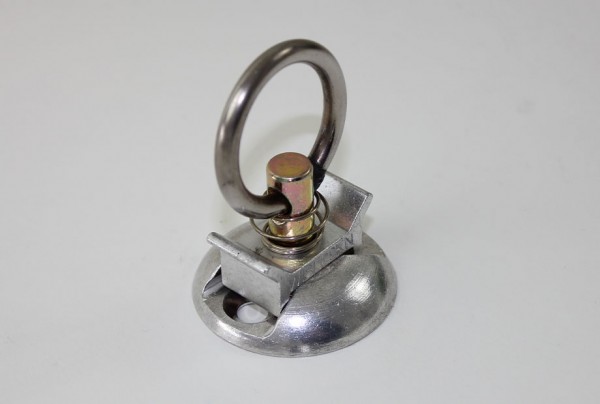Reliable transport guaranteed
A so-called lashing point is usually a shackle or ring that is factory-fitted or retrofitted inside the load floor. It is used to hold the hook of the tension straps and lashing straps. This makes securing cargo to and on transport vehicles much easier, because a lashing strap with a ratchet can be tightened much more strongly.
Tension straps as a supplement to lashing equipment
Lashing points have a specified load capacity, depending on the material, size and strength. How high the load capacity is must be marked directly at the lashing point. Accordingly, the lashing equipment, such as tension straps in conjunction with lashing tracks or even airline tracks, must be selected appropriately.
The following values can be used as a rough guideline:
- For transport vehicles with a permissible total weight of over 3.5 tonnes up to and including 7.5 tonnes, one lashing point holds 800 decanewtons (daN).
- For vehicles from 7.5 tonnes up to and including 12 tonnes in total weight, the value is 1,000 daN (decanewtons) per lashing point.
- For trucks with a total weight of 12 tonnes or more, lashing points hold 2,000 daN each.
- If there is a lashing point on the front wall of the vehicle, it will hold about 1,000 daN (1 daN corresponds to 1.02 kilograms).
Using lashing points in the cargo securing
Since the mid-1990s, companies have been obliged to equip their transport vehicles, such as low-bed trucks, platform vehicles and pickup trucks used for the commercial transport of goods (DIN EN 12640), with lashing points. Vehicles which are used exclusively for special goods or bulk goods are excluded. However, experts recommend that their trailers should also be equipped with lashing points, as they can also be used for other vehicles where tension straps or lashing tracks are necessary accessories for cargo securing.
Lashing points transfer forces that are introduced, for example, by tension straps, lashing chains or a lashing strap with ratchet, to the load-bearing elements of the transporter. If, for example, lashing troughs are to be retrofitted on a loading area, it must be ensured that sufficient bolts are used to guarantee a stable connection to the load-bearing part of the vehicle. Lashing troughs that are made of steel are welded. Lashing points must not protrude above the loading area when folded in. DIN EN 12640 also states that at least two lashing points must be mounted on the end walls of the transporters.
Furthermore, DIN EN 12640 stipulates that vehicles must have a sign indicating the permissible tensile force of the attached lashing points in a clearly visible manner.
Cargo securing systems
Among other things, box trucks play a special role in logistics. Cargo on roll containers, general cargo or palletised goods are a challenge when it comes to cargo securing, because lashing points or anchorage points are often not available. That is why, in addition to lashing tracks, it is mainly airline tracks that are retrofitted to act as cargo securing for the most varied of transport goods. The individual components such as lashing tracks accessories and tension straps can be perfectly matched to this.
The basis of the individual cargo securing systems is therefore primarily airline tracks and lashing tracks, which are attached to the side walls and the ceiling. As the assembly is very simple, the tracks can be used quickly and offer several practical advantages. With the help of lashing tracks accessories, tension rods or locking rods, any load can be secured vertically and horizontally. The systems are robust and flexible and therefore adapt easily to the characteristics of the goods.
Securing goods on open transporters
Among other things, tarpaulins and trailer nets are used to secure loads on open trailers, troughs or flatbeds. This reduces the risk of accidents caused by loose goods such as building rubble or tree cuttings. A distinction is made between covering nets and cargo securing nets.
Cargo securing nets, for example, transfer forces to the mounted lashing points of the transporter via ratchet systems and tension straps. Covering nets, on the other hand, prevent light goods such as leaves from being carried away by the wind. This type of cargo securing also requires several lashing points. Loading open vehicles can often be made easier by using suitable aids such as pallets or mesh boxes. In our online shop for cargo securing, we offer prefabricated nets in addition to lashing tracks and airline tracks.








